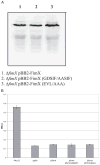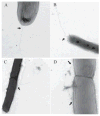Analysis of FimX, a phosphodiesterase that governs twitching motility in Pseudomonas aeruginosa
- PMID: 16677312
- PMCID: PMC3609419
- DOI: 10.1111/j.1365-2958.2006.05156.x
Analysis of FimX, a phosphodiesterase that governs twitching motility in Pseudomonas aeruginosa
Abstract
Type IV pili (Tfp) are polar surface structures of Pseudomonas aeruginosa required for twitching motility, biofilm formation and adherence. One protein required for the assembly of tfp is FimX, which possesses both GGDEF and EAL domains characteristic of diguanylate cyclases and phosphodiesterases respectively. In this work we demonstrate that FimX has phosphodiesterase activity towards bis-(3'-5')-cyclic dimeric guanosine monophosphate (c-di-GMP), but does not show diguanylate cyclase activity. Instead, the imperfect GGDEF domain of FimX likely serves to activate phosphodiesterase activity when bound to GTP, as has recently been described for the Caulobacter crescentus composite GGDEF-EAL protein, CC3396. Bacteria expressing FimX in which either the GGDEF or EAL domain is deleted or mutated have phenotypes indistinguishable from a DeltafimX strain, demonstrating the importance of both domains to function. Previous work has shown that FimX localizes to the bacterial pole. In this work we show that restriction of FimX to a single pole requires intact GGDEF and EAL domains. Deletion of the amino-terminal REC domain of FimX, which contains a putative polar localization signal, results in a protein that still supports intermediate levels of pilus assembly and function. RFP-FimXDeltaREC, unlike RFP-FimX, is no longer localized to the bacterial pole, while transmission electron microscopy shows that surface pili can originate from non-polar sites in this mutant. Although DeltafimX mutants show limited in vitro cytotoxicity, they are as virulent as the wild-type strain in a murine model of acute pneumonia.
Figures








Similar articles
-
Type IV pilus assembly in Pseudomonas aeruginosa over a broad range of cyclic di-GMP concentrations.J Bacteriol. 2012 Aug;194(16):4285-94. doi: 10.1128/JB.00803-12. Epub 2012 Jun 8. J Bacteriol. 2012. PMID: 22685276 Free PMC article.
-
Interaction of the cyclic-di-GMP binding protein FimX and the Type 4 pilus assembly ATPase promotes pilus assembly.PLoS Pathog. 2017 Aug 30;13(8):e1006594. doi: 10.1371/journal.ppat.1006594. eCollection 2017 Aug. PLoS Pathog. 2017. PMID: 28854278 Free PMC article.
-
Identification and characterization of a cyclic di-GMP-specific phosphodiesterase and its allosteric control by GTP.J Biol Chem. 2005 Sep 2;280(35):30829-37. doi: 10.1074/jbc.M504429200. Epub 2005 Jul 1. J Biol Chem. 2005. PMID: 15994307
-
C-di-GMP Synthesis: Structural Aspects of Evolution, Catalysis and Regulation.J Mol Biol. 2016 Sep 25;428(19):3683-701. doi: 10.1016/j.jmb.2016.07.023. Epub 2016 Aug 4. J Mol Biol. 2016. PMID: 27498163 Review.
-
Sensing the messenger: the diverse ways that bacteria signal through c-di-GMP.Protein Sci. 2012 Jul;21(7):929-48. doi: 10.1002/pro.2093. Epub 2012 Jun 5. Protein Sci. 2012. PMID: 22593024 Free PMC article. Review.
Cited by
-
Structure of the cytoplasmic region of PelD, a degenerate diguanylate cyclase receptor that regulates exopolysaccharide production in Pseudomonas aeruginosa.J Biol Chem. 2012 Jul 6;287(28):23582-93. doi: 10.1074/jbc.M112.375378. Epub 2012 May 17. J Biol Chem. 2012. PMID: 22605337 Free PMC article.
-
A cyclic di-GMP-binding adaptor protein interacts with a N5-glutamine methyltransferase to regulate the pathogenesis in Xanthomonas citri subsp. citri.Mol Plant Pathol. 2024 Jul;25(7):e13496. doi: 10.1111/mpp.13496. Mol Plant Pathol. 2024. PMID: 39011828 Free PMC article.
-
A novel tetrameric PilZ domain structure from xanthomonads.PLoS One. 2011;6(7):e22036. doi: 10.1371/journal.pone.0022036. Epub 2011 Jul 7. PLoS One. 2011. PMID: 21760949 Free PMC article.
-
The Anabaena sp. strain PCC 7120 gene all2874 encodes a diguanylate cyclase and is required for normal heterocyst development under high-light growth conditions.J Bacteriol. 2008 Oct;190(20):6829-36. doi: 10.1128/JB.00701-08. Epub 2008 Aug 22. J Bacteriol. 2008. PMID: 18723619 Free PMC article.
-
Cyclic di-GMP is essential for the survival of the lyme disease spirochete in ticks.PLoS Pathog. 2011 Jun;7(6):e1002133. doi: 10.1371/journal.ppat.1002133. Epub 2011 Jun 30. PLoS Pathog. 2011. PMID: 21738477 Free PMC article.
References
-
- Aldridge P, Jenal U. Cell cycle-dependent degradation of a flagellar motor component requires a novel-type response regulator. Mol Microbiol. 1999;32:379–391. - PubMed
-
- Ausmees N, Jonsson H, Hoglund S, Ljunggren HG, Lindberg M. Structural and putative regulatory genes involved in cellulose synthesis in Rhizobium leguminosarum bv. trifolii. Microbiology. 1999;145:1253–1262. - PubMed
-
- Bobrov AG, Kirillina O, Perry RD. The phosphodiesterase activity of the HmsP EAL domain is required for negative regulation of biofilm formation in Yersinia pestis. FEMS Microbiol Lett. 2005;247:123–130. - PubMed
-
- Bradley DE. A function of Pseudomonas aeruginosa PAO pili: twitching motility. Can J Microbiol. 1980;26:146–154. - PubMed
-
- Brookman JL, Stott AJ, Cheeseman PJ, Burns NR, Adams SE, Kingsman AJ, Gull K. An immunological analysis of Ty1 virus-like particle structure. Virology. 1995;207:59–67. - PubMed
Publication types
MeSH terms
Substances
Grants and funding
LinkOut - more resources
Full Text Sources
Other Literature Sources
Molecular Biology Databases
Miscellaneous

